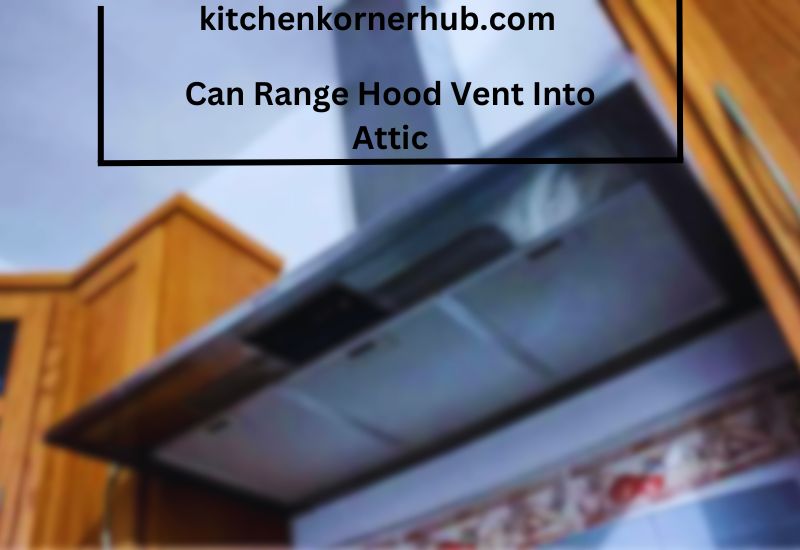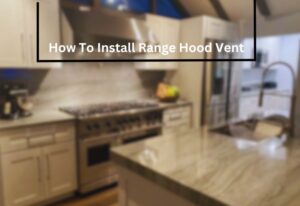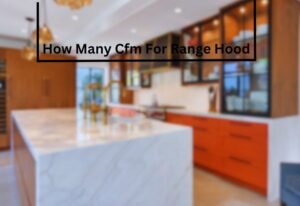Have you ever wondered if it’s okay for your range hood to vent into the attic? It’s a common question for homeowners looking to improve their kitchen ventilation. In this discussion, we’ll explore the pros and cons of this setup.
Can Range Hood Vent Into Attic? Can Range Hood Vent Into Attic? Venting a range hood into the attic is not recommended. It can lead to moisture and grease buildup, which may cause damage and create a fire hazard. Proper ventilation should route the exhaust outdoors to ensure safety and prevent structural issues in the attic.
We’ll also look at whether it’s safe and effective or if there are better alternatives for keeping your kitchen fresh and free of cooking odors. So, let’s dive in and find out if your attic can be a suitable escape route for your range hood’s exhaust or if there are better options to consider.
“Unveiling the Mystery: Can a Range Hood Vent Into the Attic Safely?”
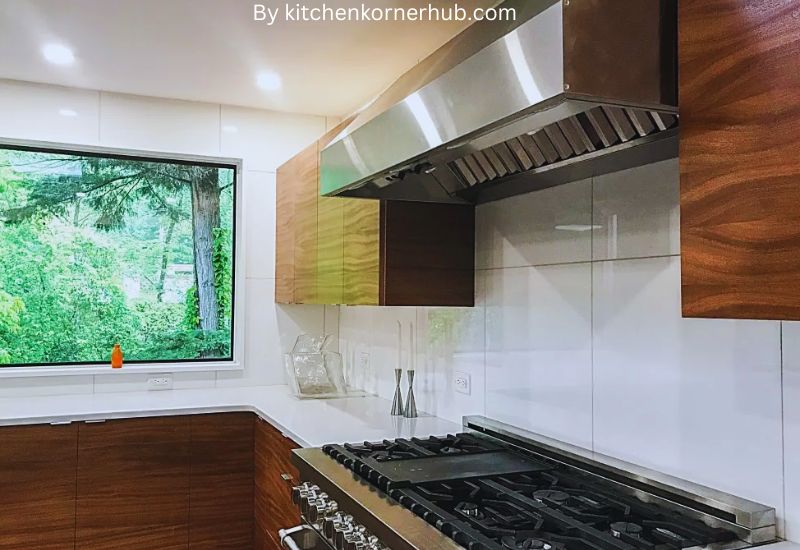
Introduction
When it comes to kitchen ventilation, a range hood plays a crucial role in keeping your kitchen fresh and smoke-free. Many homeowners wonder if it’s safe to vent a range hood into the attic. In this article, we will explore this mystery and provide you with essential information to make an informed decision for your home.
The Importance of Proper Ventilation
Proper ventilation is essential in the kitchen to remove cooking odors, heat, and harmful pollutants. A well-functioning range hood not only enhances indoor air quality but also prevents the buildup of moisture that can lead to mold and structural damage.
The Attic Conundrum
Venting a range hood into the attic may seem like a convenient option, but it comes with potential risks. Attics are not designed to handle the moisture and grease-laden air generated by cooking. Over time, this can lead to structural damage, insulation problems, and even fire hazards.
Exterior Venting:
The safest option is to vent your range hood directly outside through a wall or roof. This ensures that the polluted air is expelled from your home, preventing any potential issues in the attic.
Recirculating Range Hoods:
If exterior venting is not feasible, consider using a recirculating range hood. These units use filters to clean the air and release it back into the kitchen, effectively removing odors and some pollutants without venting into the attic.
Consider Professional Installation
Installing a range hood and ventilation system can be complex. It’s advisable to consult a professional to ensure proper installation and adherence to local building codes. A professional can help you choose the best ventilation option for your kitchen layout.
Regular Maintenance
Regardless of the venting method you choose, regular maintenance is crucial. Clean or replace filters as needed, and ensure that the ductwork is free from obstructions to maintain the efficiency of your range hood.
“The Attic Ventilation Dilemma: Exploring Range Hood Exhaust Options”

In the quest for a well-ventilated and odor-free kitchen, the role of range hood exhaust systems cannot be underestimated. However, this seemingly straightforward appliance presents a complex challenge when it comes to deciding how to ventilate its exhaust. Let’s delve into the attic ventilation dilemma and explore the various options available.
Understanding the Range Hood’s Role
Before we dive into the attic ventilation dilemma, it’s crucial to understand the purpose of a range hood. Simply put, it’s a kitchen appliance designed to remove cooking byproducts, such as grease, smoke, and odors, to maintain a fresh and clean kitchen environment.
Ducted vs. Ductless: The Core Decision
The first crossroads homeowners encounter is choosing between a ducted and ductless range hood exhaust system. Ducted hoods connect to an external duct, expelling air and pollutants outside. In contrast, ductless hoods use filters to trap contaminants and recirculate the cleaned air back into the kitchen.
Ducted Range Hoods: The Pro and Con Conundrum
Ducted range hoods offer efficient ventilation by expelling odors and pollutants outside. They provide excellent air quality and maintain the kitchen’s overall freshness. However, their installation requires a proper attic ventilation system to prevent moisture buildup and potential damage to your home’s structure.
Ductless Range Hoods: A Space-Saving Alternative
Ductless range hoods are a space-saving solution that doesn’t require attic ventilation modifications. They utilize filters to capture impurities, but they might not be as effective in removing all odors and grease. Regular filter maintenance is essential for optimal performance.
Attic Ventilation: The Hidden Hero
Whether you opt for a ducted or ductless range hood, the attic ventilation system plays a crucial role. Proper attic ventilation prevents moisture buildup, mold growth, and structural damage caused by excess humidity. Ensuring your attic has adequate ventilation is paramount for a healthy home.
Professional Guidance and Maintenance
To make an informed decision, it’s advisable to consult with professionals who can assess your kitchen’s specific needs and attic ventilation requirements. Regular maintenance of your range hood and attic ventilation system is also essential to keep them functioning efficiently.
“Venting Beyond the Kitchen: Pros and Cons of Attic Range Hood Venting”
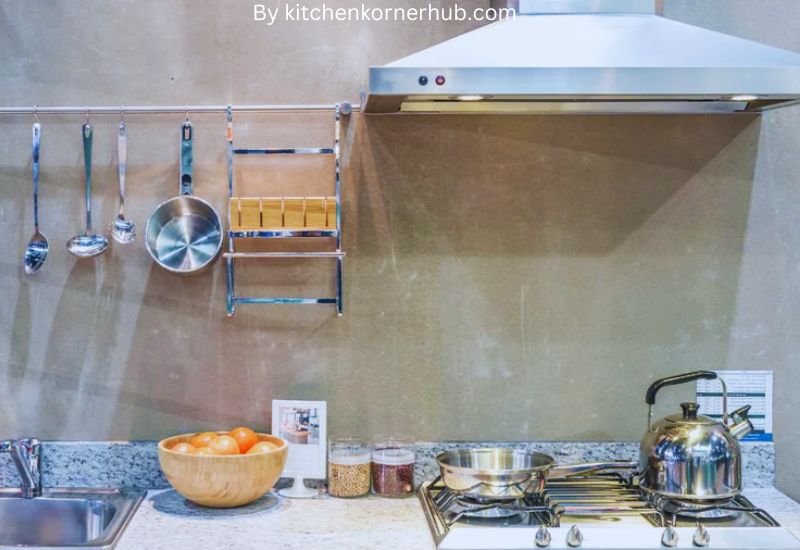
When it comes to kitchen ventilation, most people think of range hood vents that expel cooking odors and smoke directly outside. However, there’s an alternative method gaining popularity – attic range hood venting. This approach involves channeling the venting system through the attic space rather than a direct outdoor route. Before deciding whether this is the right choice for your home, it’s essential to consider the pros and cons.
Improved Aesthetics
One of the significant advantages of attic range hood venting is the improved aesthetics it offers in your kitchen. With a traditional vent, you have to install a visible duct that may disrupt the design and flow of your kitchen. Attic venting, on the other hand, keeps the ductwork hidden, allowing you to maintain a clean and seamless appearance.
Reduced Noise Levels
Kitchen range hoods can be noisy, which can be bothersome when you’re trying to have a conversation or enjoy a quiet meal. Attic venting can help reduce noise levels since the ductwork is isolated from the kitchen area. This means you can cook without the loud humming or whooshing sounds that are typical with exterior venting.
Enhanced Energy Efficiency
Attic range hood venting can contribute to improved energy efficiency in your home. The attic acts as a buffer zone, helping to keep the outdoor air temperature from affecting your kitchen. This can be especially beneficial in extreme weather conditions, as it reduces the load on your heating and cooling systems.
Potential Moisture and Odor Issues
While attic venting can be a great solution, it comes with its share of downsides. One of the primary concerns is the potential for moisture and odor issues. If not properly insulated and sealed, the ductwork in the attic can allow moisture and odors to accumulate, leading to mold growth and unpleasant smells.
Increased Installation Complexity
Installing an attic range hood venting system is more complex than a standard exterior vent. It requires careful planning and sealing to ensure that it functions correctly. Additionally, you may need to make modifications to your attic space, which could add to the overall cost and time involved in the installation.
Maintenance Challenges
Maintenance can also be more challenging with attic venting. Cleaning and servicing the ductwork in the attic can be cumbersome compared to a traditional vent that is easily accessible from the exterior. Regular maintenance is crucial to prevent blockages and maintain optimal ventilation performance.
Local Building Codes
Before opting for attic range hood venting, it’s essential to check your local building codes and regulations. Some areas may have restrictions or requirements related to this type of ventilation system. Ensuring compliance with local codes is vital to avoid potential issues down the road.
“Avoiding Attic Nightmares: A Guide to Proper Range Hood Ventilation”

In many homes, the attic is a hidden space often relegated to storing old memorabilia, forgotten belongings, or seasonal decorations. However, there’s one scenario that no homeowner wants to encounter: an attic filled with moisture and mold due to improper range hood ventilation. In this guide, we’ll explore the importance of proper range hood ventilation and provide practical tips to help you avoid attic nightmares.
Understanding the Consequences
Improper range hood ventilation can lead to serious consequences, including moisture buildup, mold growth, and structural damage. When your range hood doesn’t effectively remove cooking fumes, smoke, and excess moisture, these elements can travel upward and accumulate in your attic. Over time, this can result in the growth of mold and mildew, which not only poses health risks but can also compromise the integrity of your home’s structure.
Assessing Your Current Ventilation System
Before making any changes, it’s essential to evaluate your existing range hood ventilation system. Check the airflow and ensure that it’s functioning correctly. Often, range hoods are equipped with filters that need regular cleaning or replacement. Make it a habit to clean or change these filters as recommended by the manufacturer to maintain optimal performance.
Choosing the Right Range Hood
If your current range hood isn’t up to the task, it might be time for an upgrade. When selecting a new range hood, consider the size of your kitchen and cooking habits. A hood that’s too small for your cooking area will struggle to remove smoke and odors effectively. Additionally, opt for a hood with proper ductwork to vent the air outdoors rather than recirculating it back into the kitchen.
Proper Ductwork Installation
One of the key elements of efficient range hood ventilation is the proper installation of ductwork. Ensure that the ducts are the right size for your range hood, allowing for adequate airflow. The ducts should be as straight and direct as possible, avoiding unnecessary bends and turns that can impede airflow. Proper insulation of the ducts is also crucial, preventing condensation and moisture from escaping into your attic.
Regular Maintenance and Cleaning
To keep your range hood ventilation system in peak condition, establish a regular maintenance routine. Clean the hood’s interior and exterior surfaces, including the fan blades and filters. In addition, inspect the ductwork for any blockages or damage that may hinder airflow. Regular maintenance not only ensures efficient ventilation but also extends the lifespan of your range hood.
Seek Professional Help
If you’re unsure about your range hood ventilation system or suspect any issues, it’s always wise to consult a professional. An experienced technician can assess your setup, make necessary adjustments, and offer expert guidance to ensure your attic remains free from moisture and mold-related nightmares.
“Breaking Down the Rules: Is Attic Venting for Range Hoods Code-Compliant?”

When it comes to home improvement, one topic that often gets overlooked is the ventilation of range hoods. It may seem like a minor detail, but it’s an essential aspect of keeping your kitchen safe and odor-free. In this note, we will delve into the world of attic venting for range hoods and explore its compliance with building codes.
Understanding the Purpose of Attic Venting
Attic venting serves a crucial role in maintaining a healthy and functional home. It helps regulate temperature, prevents moisture buildup, and ensures proper air circulation. When it comes to range hood ventilation, attic venting plays a crucial part in expelling cooking odors, smoke, and airborne grease particles out of your home.
Building Codes and Their Significance
Building codes are a set of regulations that provide guidelines for constructing and renovating homes. These codes are not arbitrary; they are designed to ensure the safety and well-being of homeowners. When it comes to attic venting for range hoods, it’s important to assess whether your setup aligns with these codes to avoid potential issues down the road.
Potential Code Compliance Challenges
Venting range hoods into the attic can present challenges in terms of code compliance. Many building codes require that range hood exhaust ducts discharge to the outdoors, rather than into enclosed spaces like attics. This is because venting into the attic can lead to moisture problems, insulation damage, and potential fire hazards if not properly installed and maintained.
Alternative Solutions for Code Compliance
To achieve code compliance while still effectively venting your range hood, consider alternative solutions. Installing a duct system that directs exhaust air outside through an exterior wall or roof can be a viable option. While it may require some additional work and expense, it ensures that your home meets the necessary safety standards.
Professional Guidance and Inspection
Navigating the complexities of building codes and range hood ventilation can be daunting. Seeking professional guidance from a licensed contractor or HVAC technician can help you make informed decisions. Additionally, regular inspections of your ventilation system can ensure it continues to meet code requirements and operates safely.
Conclusion
In conclusion, venting a range hood into the attic is not a good idea. It can lead to problems like moisture buildup, mold growth, and even fire hazards. A better choice is to vent the hood outside, ensuring that cooking fumes and odors are properly expelled. This keeps your home safe, clean, and free from potential damage. So, when it comes to range hood ventilation, remember: out is better than in, for a healthier and safer home environment.
Frequently Asked Question(Can Range Hood Vent Into Attic)
Does a range hood have to be vented outside?
Yes, a range hood should ideally be vented outside to effectively remove cooking odors, smoke, and grease from your kitchen. Venting it outside ensures that these contaminants are expelled outdoors, improving indoor air quality and preventing the buildup of grease in your home.
While some range hoods can be configured for recirculation, where they filter and then release air back into the kitchen, venting outside is generally more efficient. It’s essential to consult the manufacturer’s guidelines and local building codes to ensure proper installation, ductwork, and ventilation.
Can you vent a range hood into the ceiling?
Yes, you can vent a range hood into the ceiling, but it depends on the specific hood model and the layout of your kitchen. Ceiling venting, often called “ducted ceiling venting,” involves running a duct through the ceiling and into the attic or an adjacent space.
This method can be a practical solution when there’s no direct access to an exterior wall for venting. However, it’s crucial to follow local building codes and ensure that the ductwork is properly insulated to prevent condensation and maintain efficient airflow.
Can you have a stove in the attic?
In most cases, it’s not advisable to have a stove in the attic due to safety and ventilation concerns. Attics are not designed for cooking appliances, and they lack proper ventilation systems required for safe cooking.
Cooking in the attic can pose fire hazards, as well as issues with heat buildup and inadequate ventilation, which can lead to poor indoor air quality and health concerns. It’s best to have cooking appliances, like stoves, in dedicated kitchen areas where safety measures and proper ventilation can be implemented to prevent accidents and ensure a healthy environment.
Can you vent a range hood into the garage?
Venting a range hood into the garage is generally not recommended, as it can introduce cooking odors, grease, and potentially harmful contaminants into the garage space. Garages are typically not equipped with the same ventilation systems as kitchens, which can result in poor indoor air quality.
It’s essential to prioritize safety and proper ventilation by venting the range hood outside, either through an exterior wall or the roof, to ensure that cooking byproducts are adequately expelled and do not accumulate in the garage. Always follow local building codes and manufacturer recommendations for safe and effective range hood installation.

